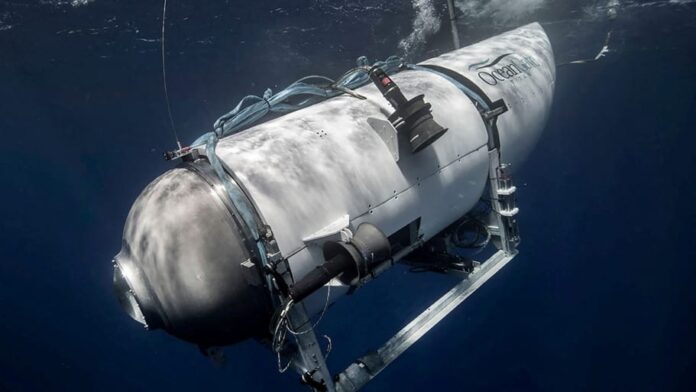
According to an expert in submersibles who spoke to The NY Post, the crew of the ill-fated Titanic submersible would have faced instant death from an implosion that occurred so quickly, “they never knew it happened.” Debris from the submersible, named Titan and belonging to OceanGate Expeditions, was found, confirming the tragic fate of all those on board.
The Coast Guard revealed that the presence of scattered debris on the ocean floor, located 1,600 feet from the front of the Titanic, indicated that the submersible experienced a “catastrophic implosion” sometime after it disappeared during its dive to the wreck. The dive had reached a depth of 12,500 feet below the surface and had been underway for one hour and 45 minutes on Sunday.
Experts interviewed by The Post explained that just before losing communication, the submersible would have been close to 10,000 feet below the surface, subject to immense water pressure. At that depth, even the smallest weakness, crack, or fissure in the submersible’s hull would have caused it to implode instantly due to the overwhelming water pressure.
Ofer Ketter, an expert and co-founder of a private submersible company called Sub-Merge, described the implosion as occurring within a millisecond, if not a nanosecond, upon breaching the hull and causing a loss in pressure. The five victims, he noted, “never knew it happened,” which was a small consolation in such a tragic situation.
Ketter further emphasized the instantaneous nature of the implosion, explaining that the crew wouldn’t have had time to register pain in their bodies before their brains could even send the signals. He provided these insights from Costa Rica, where he was located.
Sadly, the bodies of the five explorers, namely Suleman Dawood (19), his father Shahzada Dawood (48), British billionaire Hamish Harding (58), renowned Titanic explorer Paul-Henri Nargeolet (77), and OceanGate founder and CEO Stockton Rush (61), are unlikely to be recovered.
Based on the distribution of debris on the ocean floor, experts concur that the submersible most likely imploded during its descent to the Titanic wreck on the day it lost contact with the surface. At depths of approximately 6,000 pounds per square inch, the pressure exceeds the design limits of the Titan’s carbon fiber and titanium exterior, causing it to collapse under the tremendous force.
Dr. Peter Girguis, an oceanographer and professor at Harvard University, clarified that if a vessel surpasses its structural strength, it either crushes or collapses. While implosions are believed to be swift and complete, the exact details remain uncertain.
Any defect or leak, whether from inside or outside the submersible, would have led to an implosion due to the surrounding pressure forcing itself into the vessel. In 2018, the Marine Technology Society cautioned OceanGate head Stockton Rush about the critical need for proper third-party testing of its prototypes before attempting such deep dives to ensure passenger safety. However, Rush reportedly declined to comply.
The investigation into the cause of the submersible’s implosion is ongoing, and currently, there is no evidence pointing to an error on OceanGate’s part. It is also possible that due to the nature of the accident, a definitive conclusion may never be reached.
Ketter emphasized that implosions “shouldn’t happen” because submersibles can be designed to withstand the pressures at great depths. He attributed implosions to engineering miscalculations, whether in the structure, materials, testing, or seals used in the submersible. He also noted that it would have been highly unlikely for a collision to cause a puncture leading to the implosion.
Drawing from his experience, Ketter explained that submersibles are expected to be built, tested, and pressurized to withstand depths far beyond what they are likely to encounter. This ensures they can handle the extreme conditions, unlike attempting to take a hot air balloon to the moon, which is destined to fail.
The submersible vanished merely one hour and 45 minutes into its exploration of the Titanic wreckage off the coast of Newfoundland on Sunday. It had an air reserve of 96 hours. Despite reports of recurring underwater noises described as banging and tapping, which raised hopes initially, they were determined to be unrelated to the missing crew.
Search efforts covered waters as deep as two and a half miles, spanning an area twice the size of Connecticut. The Coast Guard deployed ships, airplanes, and undersea technology to scan for additional sounds in their rescue mission. Two remotely operated vessels, including the Victor 6000, were dispatched early Thursday and quickly discovered the debris fields.
Notably, the submersible’s crew was sealed inside the vessel with 17 bolts, which could only be opened from the outside.
{Matzav.com}












According to film director Cameron’s video they were well aware and attempted to resurface.
The use of the word “nanosecond” shows either asinine ignorance or deliberate misleading of non-technical readers.
Intelligent people have learned to understand mainstream media…
If Watergate, Pizzagate, Obamagate, BillGates have negative connotations, most likely Oceangate has bad association too and their official narrative of exploring the wreckage of the Titanic ship is hogwash. Anything the media keeps talking about several times a day smells very fishy… (Remember the covid/coronavirus lies how they spoke about it all day for a year? And then the media’s daily convincing of the covid vax that turned out to be lethal?)
The CEO of the company that produced the Titan submarine said that he did NOT want to hire “50 year old white men” to design his submarine.
Instead, he insisted on only hiring Politically Correct minorities to design the Titan submarine.